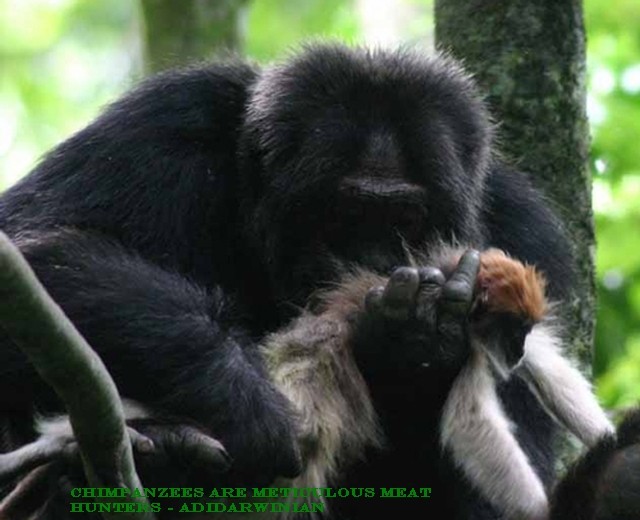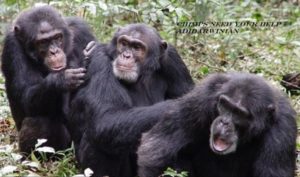Stunning Facts About Chimpanzees – You Cannot Afford To Miss!!
Chimpanzees Are Our Closest Relatives
Chimpanzees (Pan troglodytes) are the closest living relatives of the human beings. Human beings and chimps share more than 98 percent of the DNA. Chimpanzees are distributed across a west-east belt in the equatorial Africa.
Chimpanzees Show High Intelligence, Make and Use Tools like Us
Chimpanzees are very intelligent animals and make and use tools in a multitude of ways. They use more tools for more purposes than any other animal except us. The objects used as tools include twigs, stems, leaves, branches, and rocks. Chimpanzees use tools for feeding honey, termites, ants, nuts; drinking water; and for cleaning themselves. The use of tools as weapons has also been observed. Chimpanzees of the Tai National Park in Ivory Coast even use rocks to crack open nuts. Dr. Jane Goodall, an eminent primatologist, was the first one to observe a chimp using a tool in the month of November in 1960; chimpanzee was using grass as a tool to get termites. Making and using tools by animals (chimpanzees) other than humans was a major discovery in the realm of zoological sciences. Chimpanzees also use leaves as sponges to dip for water for drinking purpose.
Chimpanzees create highly intelligible mental maps of their home ranges, and use these mental maps to find food resources regularly. A mental map is an animal’s internal (mental) representation of the layout of its surroundings. A mental map shows an animal’s sense of geography and its knowledge of the elements (such as food and water sources) within the surrounding environment. Male and female chimps have been seen to use leaves to clean themselves after mating or copulation.
Chimps Have Complex Society, Developed Culture, and Feelings like Us
Chimpanzees are highly social animals with an amazingly complex culture. They exhibit enduring, affable, and supportive relationships between their family members throughout their lives. Strong mother-child bond is a well known example of their social qualities. The relationships between individual chimps within a community change over time ranging from close friendship to enmity. Social relationships can be classified as neutral, sexual, friendly, or unfriendly.
 Chimpanzees, who are the closest primate cousins of human beings, being very intelligent and social animals, are especially sensitive to emotional distress and physical pain. Like us, they express a wide range of emotions including distress, pain, anxiety, depression, empathy, grief, and pleasure.
Chimpanzees, who are the closest primate cousins of human beings, being very intelligent and social animals, are especially sensitive to emotional distress and physical pain. Like us, they express a wide range of emotions including distress, pain, anxiety, depression, empathy, grief, and pleasure.
Chimpanzees Are Natural Physicians – It’s Astonishing
“Chimpanzees are natural physicians” – how much bizarre it may sound, but this is the bare truth, an extremely interesting and extraordinary feature bestowed upon chimps by the mighty nature. Chimpanzees apparently use medicinal plants for a variety of ailments.
Biologists have observed the use of plants by chimpanzees, from thirteen different plant genera belonging to eight families, as possible medications for a multitude of diseases. The use of plants having pharmacologically active constituents has been documented in at least three chimpanzees’ populations.
Many of the plants, used by chimps, are also used by indigenous people of the regions in question for the treatment of diseases such as headaches, stomach upsets, and parasitic infections. These plants have been shown to possess constituents having antitumor, antiamebic, anthelmintic, and antibiotic properties.
The medicinal plants, for example, Vernonia amygdalina, are eaten or processed in ways different to the consumption of the normal food. Sucking out and swallowing of the bitter tasting astringent juice after chewing the pith of medicinal shoots and spitting out of the fibrous residue, is one of the methods of consuming plants of medicinal value for treating illnesses. Another method observed is swallowing of whole leaves. The low frequency and lack of seasonality in the consumption of medicinal plants by chimps are amongst the major reasons cited for the use of these plants for purposes other than normal food consumption. Other primary evidence supporting the medicinal use of plants by the chimps is that such plants are only consumed by chimpanzees who are ill.
Chimps are Meticulous Meat Hunters and Eaters
Chimpanzees not only eat fruits, leaves, leaf buds, seeds, stems, blossoms, pith, resins, barks, and insects, but also, hunt for and eat meat of small to medium-sized mammals. Chimps form a group in order to meticulously attack, kill and eat their prey, for example, a Red Colobus monkey. They share some portion of their kill with other group members who beg for the treat. Chimps almost eat whole of the prey, including its brain.
Chimps Communicate Like Us
The well developed brains of chimps allow them to communicate much like human beings do. They communicate with each other through sounds, calls, touch, body language, and facial expressions. They embrace, kiss, pat on the back, tickle, touch hands, groom each other, etc. They also exhibit intimidating and dominating behaviors by making their hairs stand on end so they look stronger and bigger. Other behaviors expressed by these African great apes include screaming, stamping their feet, rending, trailing branches, or throwing rocks.
Chimpanzees are Great Knuckle Walkers
Chimpanzees are Knuckle Walkers, that is, they walk on all of their four limbs (quadrupedal walking), using their knuckles for support (Knuckle Walking). Locomotion involving walking on all four limbs and using knuckles to partially support body weight is only seen in the African great apes (chimpanzees, bonobos, and gorillas). Orangutans (Asian great apes) walk with their fists whereas monkeys walk on their palms. The arms of chimps are longer than their legs. They use their long arms in swinging from one branch to another. This type of locomotion is known as Brachiation.
Chimps Need Your Help
Chimpanzees are included under endangered species. The major factor contributing to the reduction in the population of chimpanzees is the increase of the human activities (agriculture, mining, commercial logging, etc.) in the areas where chimps naturally live. Human efforts are the need of the time to save chimps from getting extinct. Many non-profit organizations are working in this direction including the Jane Goodall Institute.







